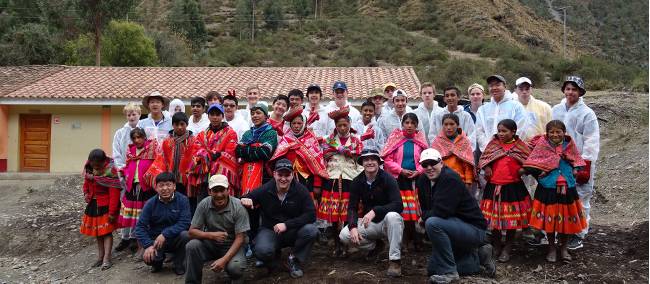
Students after the Huilloq greenhouse project in Peru | Drew Collins
Blog home / Service Learning: Tips for Volunteering Overseas
Tips for Students Volunteering Overseas
If you're in charge of organising your school's overseas Educational Travel trips the following information will help you ask the right questions of your Educational Travel provider to ensure you create a responsible, truly worthwhile experience for both your students and the host communities you plan to visit or help.
 Students on Cambodia Service Learning trip
Students on Cambodia Service Learning trip
When choosing a volunteering experience overseas be sure to use a reputable organisation, to ensure that the work you will be doing has a positive impact on the community and that it fulfils a real need.
Questions to ask:
Is the development of the volunteering experience consultative?
Has the community been involved in the decisions from the outset? Is the work needed and wanted and is it a priority for the community? Volunteer experiences that consult with or are led by the heads of the local community are usually very successful because early ownership of the project by the beneficiaries ensures long-term sustainability.
Is the volunteering collaborative?
Are you working along side members of the local community?
Is the project sustainable?
After you leave will the project continue to benefit the community? A sustainable project engages the local community with the aim that they will become self sufficient and able to operate the project themselves in the future.
Is there a transference of skills/knowledge?
Will you come away from the experience with new skills, new insights and new understandings? And are you able to leave behind the same? A transference of skills -both ways - is an ideal volunteering experience, one that is enriching for both parties.
The welfare of children in the tourism setting
Children working and living in tourist areas are especially vulnerable to physical, emotional and sexual abuse. Here are some things to consider when interacting with children during your travels and overseas volunteering experiences;
- Child begging or selling on the street: our natural reaction is to give to a child, but often this just compounds the problem. To break the cycle it is better to support their families and communities by donating to reputable children’s charities that are working to change the situation for the long term.
- Ask yourself "would this be ok in my home country?": If the answer is 'no' then you should probably not participate. Some examples, would it be ok to teach children in a school setting even though you are not qualified? Is it ok to take photos of children without the permission of their parents?
- Orphanage tourism: Legitimate orphanages employ local people to care for the children and will not allow strangers to walk through their premises to look at and interact with their vulnerable children. Corruption is rift through orphanages in South East Asia, Nepal. Remember that children are not tourist attractions. Each child deserves a stable and caring environment
- If you are going to have contact with children during a volunteer experience make sure that the organization you are with has a child protection code of conduct in place and that they ask you to provide a background check.
If you suspect a child is being abused tell your guide, or report it to the local authorities or your embassy in that country.
 Students working on a Service Learning project in Cambodia
Students working on a Service Learning project in Cambodia
Volunteering with animal welfare agency requires some due diligence to ensure that you are not inadvertently harming animals instead of helping them. Two such cased of animal exploitation in the tourism setting that are currently receiving much attention are elephants and lions.
Elephants
With so much research and evidence pointing to the fact that riding on the back of an elephant is damaging, travellers should steer clear of this experience. The best way to experience an elephant is in the wild, from the safety of a vehicle, in a national park or reserve where the elephant is not in captivity and able to display its natural behaviours. Many elephant sanctuaries / orphanages are a tourist trap, existing for the tourist dollar and not welfare of the elephants. If you must volunteer at an elephant sanctuary / orphanage do plenty of research and critic the orphanages on the following criteria:
- Is the aim to rehabilitate and release elephants into the wild. Or are the elephants kept in captivity because they attract the tourist dollar?
- Are you able to have physical contact with the elephants? If yes, remember that the only way you can have safe unprotected contact (no barrier between you and the elephant) is if that elephant has been 'crushed' - a painful process that a baby elephant endures that essentially 'breaks its spirit'. Help break the cycle and resist the opportunity to touch an elephant.
- Are the elephants kept in chains?
- Do they offer rides on the back of the elephants?
- Do the elephants have recent puncture wounds?
- Do the mahouts ask for payments for photo opportunities?
- Are baby elephants chained to railings so that tourists could pet them?
- If the answer is yes to the above 5 questions, then the motives of the sanctuary/orphanages is questionable and you should reconsider volunteering.
 Elephant's in the wild, Tanzania
Elephant's in the wild, Tanzania
Many unsuspecting tourists and volunteers in South Africa inadvertently contribute to a terrible industry called Canned Lion Hunting. Under the guise of lion conservation, lions are breed for the sole purpose of “canned” hunting. Today, anywhere between 7,000 and 8,000 predators, most of them lions, are being kept in cages or confined areas on over 150 private farms across the country. Used for a host of revenue streams – cub petting, raising “orphaned” cubs (actually cubs are removed from their mother a few days after birth which brings her back into oestrus to continue the breeding machine cycle) and “lion walking” young adult lions are ultimately shot in “canned” hunts. Close to 800 lions are killed each year by trophy hunters in enclosed or confined areas with little or no chance of escape, while hundreds more get killed and shipped to the East for the burgeoning lion bone trade.
Despite the claims of the operators, all leading conservationists and lion ecologists agree there is absolutely no conservation merit whatsoever in any of these practices.
By supporting these “lion reserve” facilities day visitors or volunteers are directly contributing to the funding of this industry, and the misinformation that confuses conservation messages and priorities, resulting in a misdirection of valuable conservation funding away from the real threats facing wild animals.
There are a number of organizations campaigning against this Canned Lion Hunting
Take a look at:
www.fortheloveofwildlife.org.au or www.facebook.com/volunteersbeware